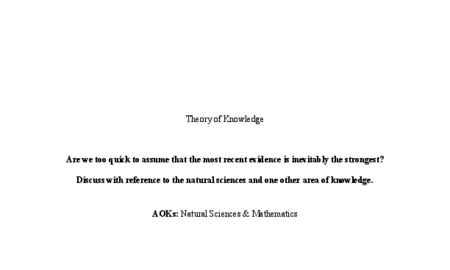Click here to explore thousands of marked IA, EE and TOK exemplars!
TOK essay format and structure
By Julia
•
May 10, 2024
Is your TOK essay deadline coming up? Do you know how to correctly structure your work? Clastify is here to help! This guide contains our recommendations on formatting and structuring such essays. We base our tips on our extensive experience helping IB students achieve the best marks for their coursework.
TOK essay format and structure
A TOK essay should include the following: the introduction, 1st Area of Knowledge, 2nd Area of Knowledge, and the conclusion. The AOK sections should be subdivided and contain both arguments and counterarguments relating to the area under study. The word count cannot exceed 1,600 words.
Introduction
Start your TOK essay with a short introductory section. Here, you'll introduce the prescribed title, clarify essential terms relevant to your investigation, and provide a brief overview of your strategy for addressing the research. Choosing the right prompt from the list of prescribed titles is crucial, so take some time. Don't settle on the easiest title, think of interesting examples to support your analysis and various perspectives that you can include.
This essay is worth taking a look at.
First Area of Knowledge
In your TOK Essay, you must analyse 2 Areas of Knowledge. Sometimes you have full independence, while in other cases one AOK is already stated. After having chosen the fields that will be subject to your study, move on to their analysis.
Each Area of Knowledge should be approached from 2 contrary perspectives. Therefore we suggest dividing it into 2 paragraphs. First, state a claim in reference to the chosen prescribed title and use examples from an appropriate subject to support it. Clearly describe what is the relation between the prompt and the example. Next, you are expected to present an opposing view. Again you must base your counterclaim on real-life cases making references to the analysed Area of Knowledge. Finally, balance the presented evidence and briefly conclude your view on the topic in relation to this AOK.
See here to get a glimpse of the matter.
Second Area of Knowledge
Analogically, you should investigate the second Area of Knowledge in the context of the prescribed research question. Repeat the structure:
first argument - state a claim concerning the title
a real-life example drawn from the AOK - present an example from the analysed field of study that will support your argument
explanation - clearly explain how the described case reflects on the study
second argument (counterargument) - state an argument with a contrary view
a real-life example drawn from the analysed AOK - relate to objects, theories, history, events, or developments from this Area of Knowledge.
explanation - use the example to support the second argument
brief summary - present the key takeaways from the analysis
Check out this exemplar for inspiration.
Conclusion
After having presented the various perspectives on the topic, summarize your view in the conclusion. In this section, you'll conclude your investigation and respond to the research question. Highlight the key findings. You should also emphasize the importance of investigating this subject and suggest potential avenues for expanding upon your research.
This essay has a good conclusion.
TOK Essay Tips
Remember about the maximum word count and proper allocation of words between the sections. We recommend the following distribution to write a balanced essay:
Introduction - around 150 words
First Area of Knowledge - 2 x 300 words
Second Area of Knowledge - 2 x 300 words
Conclusion - around 250 words
Also, keep in mind the assessment criteria:
Throughout the entire essay keep focus on the title and make strong connections to the Areas of Knowledge.
Make sure to acknowledge different perspectives while examining the 2 AOKs.
Keep the essay critical and argumentative.
Maintain a logical structure.
The arguments should be logical and well-supported with concrete examples.
Provide justifications and explanations where necessary.
Evaluate your findings and form mini-conclusions.
Properly acknowledge the sources and include in-text citations.
We are hoping that you are now one step closer to writing a perfect TOK Essay!
If you are looking for examples to use for references in the writing process, you must check out the variety of free TOK Essays available on Clastify. We also recommend visiting our blog for more guides and tips regarding completing a high-scoring IB coursework.

Useful Pages
Company
Copyright © 2025 Clastify
All content on this website has been developed independently from and is not endorsed by the International Baccalaureate Organization. International Baccalaureate and IB are registered trademarks owned by the International Baccalaureate Organization.











